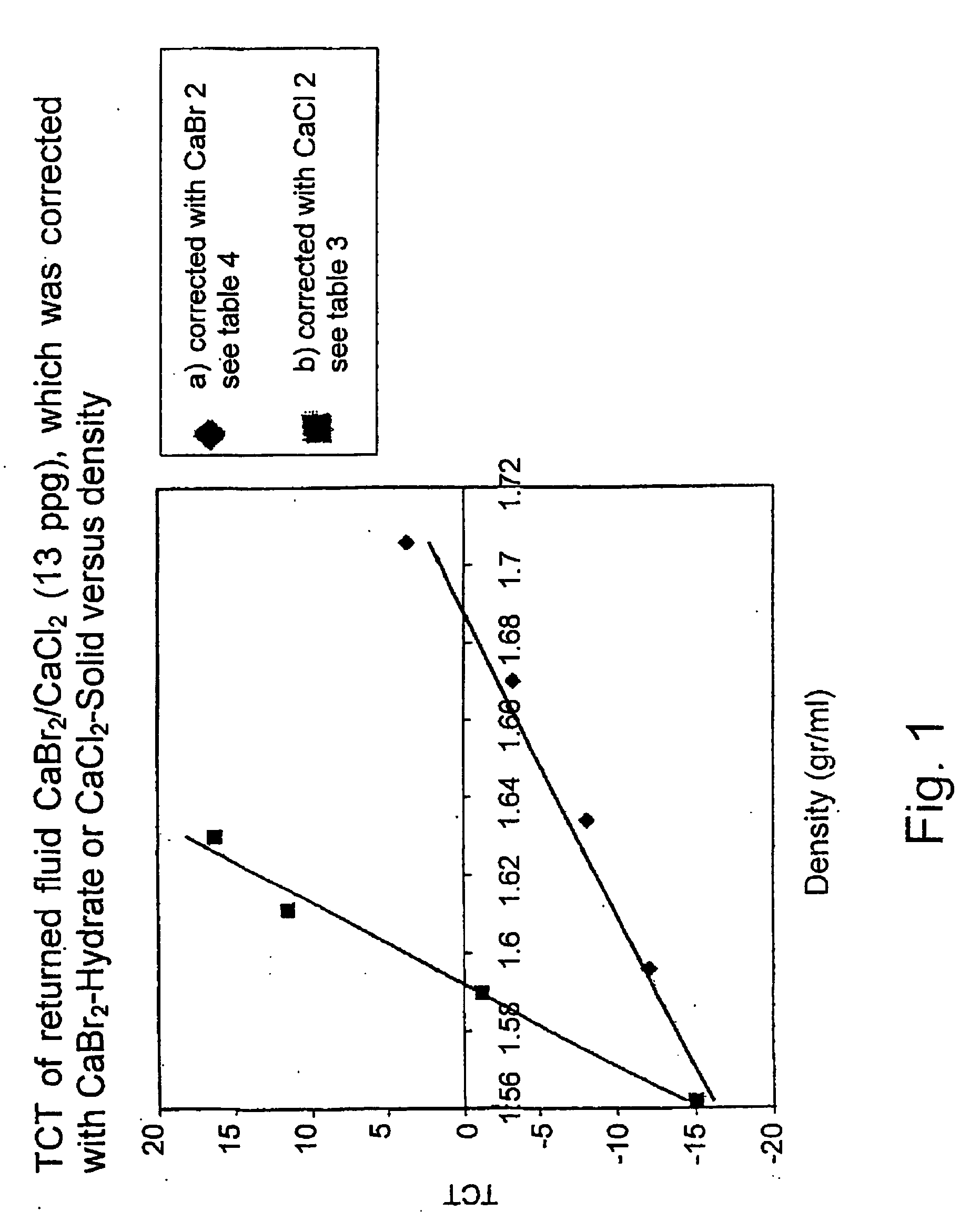Process for the preparation of cabr2 hydrates and uses thereof
a technology of cabr2 and hydrate, which is applied in the field of production of calcium bromide hydrate, can solve the problems of hygroscopic fluids based on a high concentration of salt, improbability of existence of trihydrates of halides, and affecting the stability of cabr2 hydrate, so as to reduce/minimize the solvent water
- Summary
- Abstract
- Description
- Claims
- Application Information
AI Technical Summary
Benefits of technology
Problems solved by technology
Method used
Image
Examples
example 1
[0039] 100 kg of CaBr2 52% were introduced into a 250 L agitated glass lined reactor. Vacuum of 80 mbar was applied and then the reactor was heated up to 13520 C. The resulting solution / melt contained 73.5% CaBr2 . The melt was poured on a Hastelloy C drum of a 0.1 m2 flaker, at a rate of 15-60 kg / h. The drum rotated with the speed of 1-3 rpm, and was cooled by brine with a temperature between from 10° C. to +25° C. The liquid solidified homogeneously over the drum, in a layer 2-7 mm thick, depending on the feed rate and the speed of the drum. The solid was removed from the surface by a scratching blade. Most of the flakes had the length of 0.5-5 cm. About 10% were obtained as dust, i.e. particles below 1 mm.
example 2
[0040] The melt obtained as in Example 1 was poured on a horizontal Hastelloy C belt of solidifier.
[0041] The belt was 50 cm wide and 10 m long. The flow rate of the feed was between 1000 and 2500 kg / hr. About 80% of the melt solidified within the first 5 meters of the belt. The temperature of the melt was 130° C. The belt was cooled with cooling water at 30° C. The leaving solids were quite hot—above 50° C. Their longest dimension was up to 15 cm. The product was further crushed to an average size of 3 cm2, in order to enable efficient packing .No dust or fine particles were observed. It is difficult to determine the shape of the crystals, due to their hygroscopity. It is clearly noted that while the flakes of the tetrahydrate are almost transparent, a small increase of the concentration of CaBr2, e.g. 75% instead of 73.5%, yields crystals that are snow white but totally opaque. This phenomenon has no influence on the solubility or hygroscopicity of the solid and has no practical ...
example 3
[0043] 10 tons of depleted brine had to be upgraded to a specific gravity of 1.5. Said depleted brine has a specific gravity of 1.35 and contains 33% CaBr2. The resulting brine with specific gravity of 1.5 contains 41% CaBr2. One may operate according to either of two options.
[0044] Option 1—Using a standard 52% solution, with specific gravity of 1.71, 7.27 tons of said solution brine are needed to upgrade 10 tons of depleted brine and obtain 17.27 tons of brine having the desired specific gravity of 1.5.
[0045] Option 2—Using CaBr2 tetrahydrate with 73.5% CaBr2, 2.5 ton of solid permit to obtain 12.5 tons of upgraded brine having the desired specific gravity.
[0046] It is seen that the amount of CaBr2 tetrahydrate needed to upgrade the depleted brine is only ⅓ of the amount of 52% CaBr2 solution that would be needed for the same purpose. This is an advantage, that is particularly important when the amount of said 52% solution is similar to or higher than the amount of the depleted...
PUM
| Property | Measurement | Unit |
|---|---|---|
| temperature | aaaaa | aaaaa |
| temperature | aaaaa | aaaaa |
| density | aaaaa | aaaaa |
Abstract
Description
Claims
Application Information
 Login to View More
Login to View More - R&D
- Intellectual Property
- Life Sciences
- Materials
- Tech Scout
- Unparalleled Data Quality
- Higher Quality Content
- 60% Fewer Hallucinations
Browse by: Latest US Patents, China's latest patents, Technical Efficacy Thesaurus, Application Domain, Technology Topic, Popular Technical Reports.
© 2025 PatSnap. All rights reserved.Legal|Privacy policy|Modern Slavery Act Transparency Statement|Sitemap|About US| Contact US: help@patsnap.com

